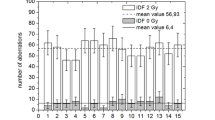Abstract
The origin of multiaberrant cells (MACs) was studied by comparing the structure and intensity of chromosome damage in peripheral blood lymphocytes of two groups of people: workers of Siberian Chemical Plant differing in the content of plutonium-239 in their bodies, and inhabitants of a non-polluted settlement (control group). Plutonium-239 is known to be a long-lived densely-ionizing source of α-radiation with high linear energy delivery; therefore, it has a stronger effect on cell hereditary structures than γ-rays. In persons with the content of plutonium-239 higher than 13 nCu, the frequency of MAC was 0.105% which at least tenfold exceeds the spontaneous level. The chromosome-type aberrations that are usually induced by ionizing radiation predominated in MACs. Our results suggest that MAC formation may be caused by internal body irradiation with the incorporated sources of densely-ionizing radiation.
Similar content being viewed by others
REFERENCES
A.D. Bloom J.V. Neel K.W. Choi et al. (1970) ArticleTitleChromosome Aberrations among the Yanomamma Indians Proc. Natl. Acad. Sci. USA 66 920–927
A.A. Awa J.V. Neel (1986) ArticleTitleCytogenetic “Rogue” Cells: What Is Their Frequency, Origin, and Evolutionary Significance Proc. Natl. Acad. Sci. USA 83 1021–1025
J.R. Lazutka (1996) ArticleTitleChromosome Aberrations and Rogue Cells in Lymphocytes of Chernobyl Clean-Up Workers Mutat. Res. 350 315–329
D.C. Lloyd A.A. Edwards A. Leonard et al. (1988) ArticleTitleFrequencies of Chromosomal Aberrations Induced in Human Blood Lymphocytes by Low Doses of X-rays Int. J. Radiat. Biol. 53 49–55
N.P. Bochkov L.D. Katosova (1994) ArticleTitleAnalysis of Multiaberrant Cells in Lymphocytes of Persons Living in Different Ecological Regions Mutat. Res. 323 7–10
J.V. Neel A.A. Awa Y. Kodama et al. (1992) ArticleTitle“Rogue” Lymphocytes among Ukrainians Not Exposed to Radioactive Fall-Out from the Chernobyl Accident: The Possible Role of This Phenomenon in Oncogenesis, Teratogenesis, and Mutagenesis Proc. Natl. Acad. Sci. USA 89 6973–6977
Y.R. Ahuja G. Obe (1994) ArticleTitleAre Rogue Cells an Indicator of Cancer Risk Due to the Action of Bacterial Restriction Endonucleases? Mutat. Res. 310 103–112
M.A. Pilinskaya A.M. Shemetun S.S. Dybskii et al. (1994) ArticleTitleDetection of Multiaberrant Lymphocytes by Cytogenetic Examination of Several Groups of People Exposed to Mutagenic Factors Tsitol. Genet. 28 IssueID1 27–32
L. Zaks (1976) Statisticheskoe otsenivanie Statistika Moscow
N.P. Bochkov A.N. Chebotarev (1989) Nasledstvennost’ cheloveka i mutageny vneshnei sredy Meditsina Moscow
J. Major M. Jakab A. Tompa (1998) ArticleTitleGenotoxicological Monitoring of 175 Subjects Living in the Green Belts, Inner Town or Near Chemical Industrial Estates in Greater Budapest Agglomeration, Hungary Mutat. Res. 412 9–16
A.N. Chebotarev (2000) ArticleTitleA Mathematical Model of Generation of Multiaberrant Cells by Spontaneous Mutagenesis Dokl. Ross. Akad. Nauk 371 IssueID6 847–849
N.P. Bochkov N.A. Popova L.D. Katosova et al. (1999) ArticleTitleUnusually High Level of Chromosomal Variability in Human Peripheral Lymphocyte Cultures Russ. J. Genet. 35 IssueID6 713–716
P. Bruckert R. Kappler H. Scherthan et al. (2000) ArticleTitleDouble Minutes and c-MYC Amplification in Acute Myelogenous Leukemia: Are They Prognostic Factors? Cancer Genet. Cytogenet. 120 73–79
I.J. Govberg J.L. Wolf P.D. Cotter (2000) ArticleTitleTrisomy 4 and Double Minutes in Acute Myeloid Leukemia: Future Evidence That Double Minutes Can Occur as the Primary Cytogenetic Abnormality Cancer Genet. Cytogenet. 121 212–215
Author information
Authors and Affiliations
Additional information
Translated from Genetika, Vol. 40, No. 12, 2004, pp. 1709–1713.
Original Russian Text Copyright © 2004 by Popova, L. Nazarenko, S. Nazarenko.
Rights and permissions
About this article
Cite this article
Popova, N.A., Nazarenko, L.P. & Nazarenko, S.A. Mutliaberrant cell formation caused by exposure to internal densely-ionizing irradiation. Russ J Genet 40, 1419–1422 (2004). https://doi.org/10.1007/s11177-005-0014-z
Received:
Revised:
Issue Date:
DOI: https://doi.org/10.1007/s11177-005-0014-z




